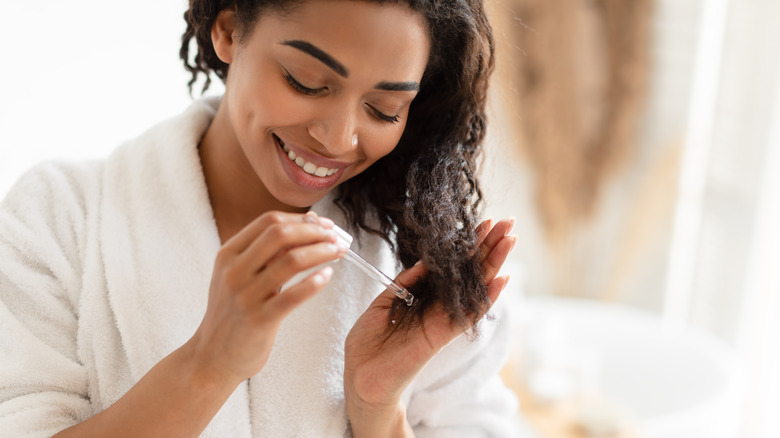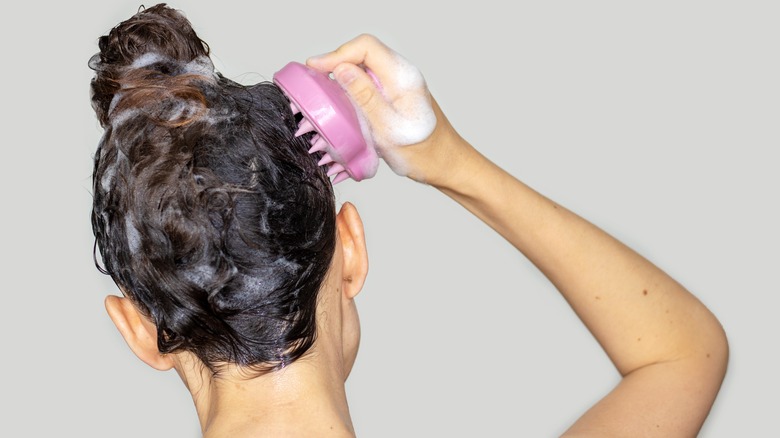Protein Filler Might Be The Perfect Hair Treatment For Strengthening Your Damaged Locks
We may receive a commission on purchases made from links.
Having dull and broken hair can be incredibly frustrating. There are thousands of products out there promising to restore the health and shine of your locks in just one easy step. But, finding one that actually works can be an exhausting hunt not to mention a total waste of money. If you don't know exactly what you're looking for, it's easy to get swept up in all the pseudo-scientific branding out there.
Thankfully, one tried and true treatment that you can trust is protein filler. Keratin, a type of protein, is the primary structural element of a hair strand. Nikki Goddard, certified hairstylist and makeup artist, explained to Vital Proteins that, "Basically, hair contents are 15% water, 6% lipids, 1% pigments, and 78% protein." When these proteins undergo chemical or thermal damage, protein filler can help them repair their structure.
As celebrity hairstylist Annagjid "Kee" Taylor elaborated in an interview with Mind Body Green, "A good protein treatment can aid in the repair of severely damaged hair, hair growth, and the penetration and healing of a dry, flaky scalp." However, this is only true depending on what kind of state your hair is originally in.
How protein filler treatments work
We all know that most styling methods aren't exactly great for general hair health. Bleach, heat tools, dyes, and chemical treatments are just a few of the ways we voluntarily abuse our innocent locks. As hairstylist Tatum Neill told Byrdie plainly, "In the process of thermal styling and coloring, often the hair cuticle becomes damaged, frayed, and can flower open. When the cuticle has flowered open, it creates opportunities for damage."
And, when this cuticle is opened up, the hair loses its ability to retain moisture. However, "Protein fillers go into those flowered cuticles at a microscopic level and fill in the gaps, which strengthens the hair and prevents breakage." In fact, a 2018 study published by Biotechnology Reports found that when the keratin protein K31 was used to treat damaged hair, the thickness of subjects' hair increased by 49%.
In addition, the protein treatment also increased the strength of previously bleached hair by almost 200%. But, while this all sounds great, don't rush out to buy a protein filler treatment just yet.
Whether you should try protein filler
While protein can be helpful for some hair types, if you don't need it, it can actually do more harm than good. A reliable way to tell if your locks could use some protein filler is to evaluate their resiliency. NYC-based hairstylist Matt Newman shared an easy way to test this elasticity with Mind Body Green. He suggested that you grab a hair from your head, or one that has already fallen out, and pull it apart from both ends. If it tears in half, you might need some protein filler.
Newman remarked that if your hair is healthy, "It should have a little bit of stretch, and it should resist your tug." Thus, if it doesn't snap and passes the test, you should avoid protein treatments. When your hair already has a sufficient supply, too much protein could lead to damage. As physician Dr. Alice Williams told Vegamour, "If you're experiencing a protein overload, your hair might feel dry, stiff, and difficult to manage."
If you do want to try it out, applying a protein filler treatment once a week or even every couple of weeks should suffice. If your hair is indeed brittle and unruly, protein filler could be a good solution — as long as you don't treat it as a miracle cure, of course.


